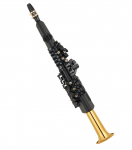
https://uk.yamaha.com/en/products/musical_instruments/winds/digital_wind_instruments/yds_series/index.html
https://www.sax.co.uk/yamaha-yds150-digital-saxophone.ir

Agree that it is pretty lame that they didn't include any sounds (nor any video of someone actually playing it).I read all the materials and manual...so is there an acoustic sound that comes from the bell or is it just for the magic resonance feedback feel? Incredibly lame that the Yamaha video has no audio examples.
So it seems it's "just" a regular wind controller with a speaker in a fancy brass bell. I don't know if it works as they claim, but as a whole it does look pretty cool compared to competition.Drawing on our extensive know-how and experience of making acoustic instruments, we designed this bell to gorgeously reproduce the long reverberation peculiar to wind instruments as well as the delicate sonic nuances sounds when playing pianissimo. Moreover, the authentic resonance causes the entire instrument to vibrate, and lets you truly feel the music as you play it.
Substantively, and getting to the heart of the bell's function . . . Is it a one or two-piece bell? Is it annealed? Is it hand hammered? Is it yellow brass or French brass? Once those questions are answered, we can determine the true quality of this instrument.To all wondering about the function of the bell:
So it seems it's "just" a regular wind controller with a speaker in a fancy brass bell. I don't know if it works as they claim, but as a whole it does look pretty cool compared to competition.
Don't let that stop you... GAS is GAS!... I really don't have a particular use for a " silent" horn but you never know.
...
Thanks for the detailed feedback!That's the question I'm asking myself. The answer is that the Aerophone and the EWI both have different things about them that I like and different things I don't like. For the EWI solo, I like that there are 200 sounds compared to the Aerophone's 120, but I like the sound of some of the Aerophone's sounds better. I like that the Aerophone has upper left hand palm keys where the EWI doesn't. But the EWI has a 7-octave range compared to the Aerophone's 5 octaves. I like the EWI's rechargeable battery compared to the Aerophone's 6 AA batteries. Some people don't like the clicking of the keys on the Aerophone which you have to press down compared to the EWI on which the "keys" are contacts which don't move. I can play fast on the Aerophone but it seems like I'm faster on those contacts that don't move. The Aerophone is louder unamplified, but I play them both through a QSC powered speaker. The Aerophone is stereo so I can run it out to 2 stereo speakers. The EWI is mono. I've far more playing time on the Aerophone so right now I prefer it, but the more I play the EWI, the more I like it. I just wish it had those upper left hand palm keys. Old muscle memory dies hard.
